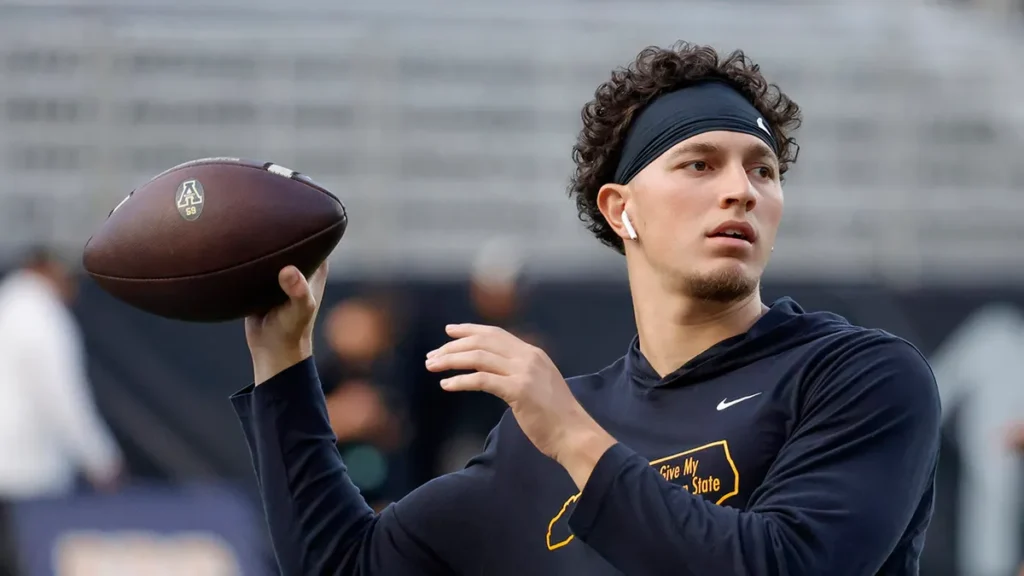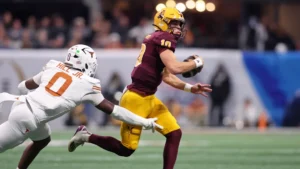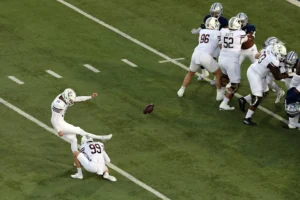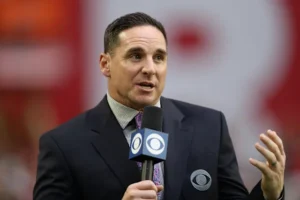
Iamaleava for Aguilar: Did Tennessee Win College Football’s First Ever Trade?
In the ever-evolving world of college football, where the transfer portal has blurred the lines between recruitment and free agency, a new era may have unofficially begun. While there’s no formal trade system in place like in professional sports, the sequence of events between Tennessee and Ole Miss this offseason feels remarkably like the sport’s first real “trade.” On one side: Nico Iamaleava, the highly-touted, former five-star quarterback who was once crowned the future of the Volunteers. On the other: Jaxson Dart heading to the NFL and the Rebels plucking a promising replacement in Iamaleava—only for Tennessee to fill their sudden quarterback void with the equally electric and proven Washington State transfer, Cameron Ward—until, wait—Ward veers to the NFL. Enter Samford’s stud and national breakout star, Michael Hiers? Nope. Tennessee shocks everyone by landing a different quarterback from the portal: New Mexico State’s Diego Pavia? No. Finally, Tennessee goes all-in on a dark-horse rising star—Coastal Carolina’s Grayson McCall? Close again, but no.
In the end, the man they brought in was none other than Jalen Milroe. Just kidding.
The real answer was actually more intriguing: Tennessee replaced Nico Iamaleava with former Appalachian State quarterback Joey Aguilar—a gunslinger with the kind of numbers that sneak up on you until you realize they weren’t a fluke. And just like that, the “trade” was complete.
Tennessee, whether by design or divine improvisation, may have executed the first of its kind: a star quarterback leaving for a blue-blood SEC program, and another rising star coming in from a lower-profile school to fill the void. Iamaleava for Aguilar. Different styles. Different pedigrees. Same high expectations.
Now the question is: who won?
Iamaleava’s departure was seismic in Knoxville. The California native was supposed to be the chosen one. Billed as the top quarterback prospect in the 2023 class by some recruiting outlets, he arrived with a cannon for an arm, blazing speed, and charisma to match. He was the face of the NIL era, earning a reported $8 million deal before he had ever thrown a collegiate pass. And when he finally got his chance to start—most notably in the Citrus Bowl against Iowa—he didn’t disappoint. His four-touchdown, MVP-level performance seemed to confirm everything Tennessee fans had been hoping for: the future was finally here, and it wore No. 8.
But things change fast in college football. Despite that performance, there were rumblings behind the scenes. Some speculated Iamaleava didn’t fully embrace Josh Heupel’s high-speed offense. Others pointed to off-field dynamics, NIL expectations, or simply the fact that in this new age, even “QB1” isn’t guaranteed to stick around. When Ole Miss came calling with an offense better suited to his improvisational skills, an NFL-friendly scheme, and a massive NIL package, it made sense. Lane Kiffin wanted a quarterback who could elevate his wide-open attack to the next level. And Iamaleava wanted a stage. In Oxford, he gets both.
But while Ole Miss celebrated, Tennessee had a decision to make: panic or pivot.
Enter Joey Aguilar.
On the surface, Aguilar wasn’t the obvious answer. A junior college product who played at Diablo Valley College before transferring to App State, Aguilar had one year as a full-time starter for the Mountaineers. Yet in that one year, he lit up the stat sheet with 3,757 passing yards, 33 touchdowns, and only 10 interceptions. He led App State to a Sun Belt Championship appearance and a bowl win over Miami (Ohio). More importantly, he showed poise in the pocket, a quick release, and enough mobility to extend plays. His deep ball was a weapon, his intermediate game was polished, and his decision-making improved as the year went on.
What stood out to Tennessee—and maybe what they learned from the Iamaleava experiment—was Aguilar’s system fit. He’s tailor-made for Heupel’s lightning-paced offense. He gets the ball out fast. He can process quickly. And perhaps most importantly, he wants to be there. After grinding his way from JUCO to the Sun Belt to Rocky Top, Aguilar isn’t chasing a brand or an NIL deal. He’s chasing the moment.
For Tennessee, that’s everything.
So again: who won?
If you’re judging by recruiting pedigree, it’s easy to say Ole Miss. Iamaleava is a potential first-round NFL talent with off-the-charts tools. His ceiling might be higher than any quarterback to ever wear a Tennessee uniform. If he pans out, the Rebels could be looking at their best quarterback since Eli Manning. That’s not hyperbole—it’s the upside Iamaleava brings.
But upside doesn’t always win games. Fit matters. Consistency matters. And so does timing.
Aguilar might not have the star power, but he has the skill. He threw more touchdowns last season than Iamaleava has collegiate completions. He’s battle-tested. He knows how to carry a team when the lights are bright. He knows how to lose, how to bounce back, how to lead. That experience matters in the SEC, especially with Tennessee facing a brutal 2025 schedule that includes Georgia, Alabama, Oklahoma, and Florida.
And let’s not forget this: Aguilar doesn’t need to become a Heisman candidate to validate Tennessee’s decision. He just needs to win games. If he leads the Vols to nine or 10 wins, puts up 3,500 yards and 30 touchdowns, and beats one of those marquee opponents, Tennessee fans will call the “trade” a win.
The ripple effects of this exchange could be huge. If both quarterbacks thrive, we might look back at this offseason as a landmark moment—when college football’s transfer portal quietly became a de facto trade market. One team loses a starter, another fills the void, and everyone comes out with something better suited to their needs. Coaches are no longer just recruiting high schoolers—they’re trading assets, recalibrating depth charts, and playing chess in real-time.
There are risks on both sides. If Iamaleava struggles at Ole Miss, critics will say he wasn’t ready. If Aguilar flops in Knoxville, Tennessee fans will wonder how they let a once-in-a-generation recruit slip away. But if both flourish, it changes the narrative. It shows that college football, like its pro counterpart, is about adaptability, not just star rankings.
There’s also a cultural aspect to consider. Aguilar brings a different energy to Tennessee’s locker room. He’s older, more mature, less polished in the media but more grounded in experience. That contrast might be exactly what the Vols need. In a room full of blue-chip talent and big expectations, having a gritty leader who’s taken the long road to get here might be the glue that holds it all together.
Iamaleava, meanwhile, walks into a team with championship ambitions and one of the SEC’s best offensive minds in Kiffin. It’s a high-stakes bet for both sides. If it hits, it could catapult Ole Miss into the playoff picture. If not, it could leave the Rebels scrambling again next year, wondering if the flash was worth the gamble.
One thing’s for sure: fans are watching this with a new lens. The idea of “player-for-player” swaps might have been foreign just a few years ago. Now, it feels inevitable. As long as the transfer portal remains open and NIL deals are in play, these unspoken trades will keep happening. And if more of them turn out like this one—with both teams finding legitimate answers at the game’s most important position—it might not be long before someone tries to formalize it.
So did Tennessee win the “trade”? It’s too early to say definitively. But they didn’t lose. They found a quarterback who fits their system, wants to be there, and has already produced at a high level. They avoided a rebuild, stabilized their offense, and kept the momentum rolling after a season that ended with promise.
Meanwhile, Ole Miss got a star. A wild card, yes—but a potentially game-changing one.
In the end, maybe the better question isn’t who won the trade—but whether college football just entered a new era because of it.





